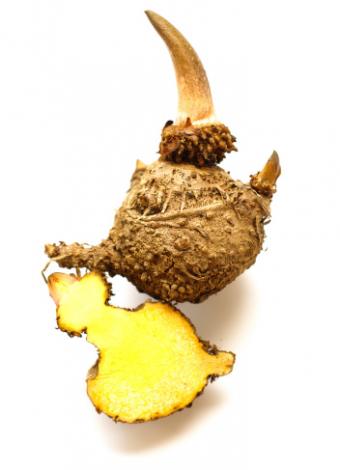
Konjac root, commonly referred to as glucomannan, has been used in Japanese medicine and cuisine for centuries. There are many uses of konjac root and if you're interested in trying this natural ingredient, make sure you understand the claims and cautions.
Health Claims
Konjac root comes from the konjac tree which is native to eastern Asia including the countries of Japan, China and Indonesia. Glucomannan is actually a water soluble fiber derived from the konjac root and is responsible for many of konjac's health claims.
Weight Loss
Konjac root is probably best known for its weight loss benefits thanks to its glucomannan content. It's believed that glucomanna swells and forms bulk in the intestines, making you feel fuller longer. As a result, appetite is suppressed, which may help you lose weight.
One PubMed abstract review of glucomannan and obesity states there is evidence the substance promotes fecal energy loss and satiety; however, it also indicates the need for more investigation. A study performed by Peninsula Medical School was aimed at reviewing various glucomannan weight loss research. The review concluded that "the evidence from available RCTs [randomized controlled trials] does not show that glucomannan intake generates statistically significant weight loss."
While studies seem mixed, the University of Maryland Medical Center still recommends glucomannan as a supplement to consider to treat obesity. They recommend taking one gram, three times a day, one hour before meals.
Relieves Constipation
Thanks to its bulking ability providing a laxative effect, glucomannan has been used as a natural remedy for constipation. One diet controlled study of seven constipated people performed by Chung Shan Medical University in Taiwan determined konjac glucomannan promoted bowel movements by 30 percent.
Lowers Cholesterol
According to the University of Michigan Health System's website (UMH), there is reliable data showing glucomannan lowers cholesterol. Controlled, double blind studies have shown the supplement not only reduces total cholesterol, triglycerides and LDL cholesterol but, in some cases, also raised HDL (good) cholesterol. UMH indicates that four to thirteen grams of glucomannan per day seems to be effective.
Fights Diabetes
According to Drugs.com, glucomannan helps reduce blood sugar levels and insulin surges after eating. A Mahidol University study in Thailand found that glucomannan given to subjects with type 2 diabetes before eating resulted in a rise of blood sugar levels without greatly affecting insulin levels. The study concluded that glucomannan supplementation may benefit type 2 diabetics.
Side Effects
Drugs.com lists the following potential glucomannan side effects:
- Severe esophageal obstruction
- Loss of blood sugar control in diabetics
- Hypoglycemia
- Gastrointestinal obstruction
- Cholestatic hepatitis
- Occupational asthma
- Diarrhea
- Gas
- Bloating
How to Use
Konjac root comes in many forms for culinary and medicinal use. The Japanese are known for cooking with konjac root. It's often consumed as a cake (yam cake) or noodles (shirataki). You can find yam cake or shirataki noodles at most Asian food stores. Gluten-free konjac powder or flour can be used as a thickener for sauces, pies, gravies custards or stews.
If cooking with konjac doesn't appeal to you, it's still possible to reap its benefits by taking glucomannan supplements.
A Fantastic Fiber
Konjac root is earning a name for itself as a fantastic fiber. In fact, Dr. Mehmet Oz once said on his television show that konjac root "is the most potent natural fiber" that he knows of.
Although there is evidence to support the safety of konjac root, using it is not without risk. To reduce your risk of unwanted side effects, please consult your doctor before using konjac root products or taking glucomannan supplements, especially if you have diabetes, hypoglycemia, are pregnant or breast feeding, or have another medical condition.







